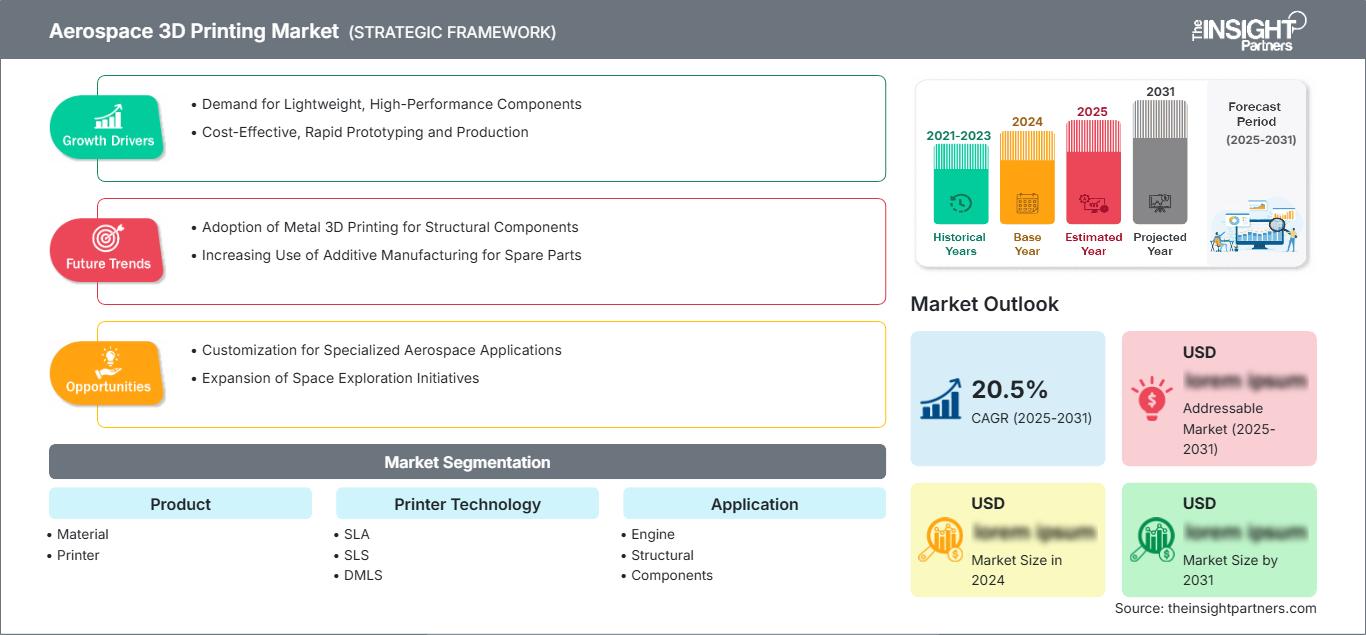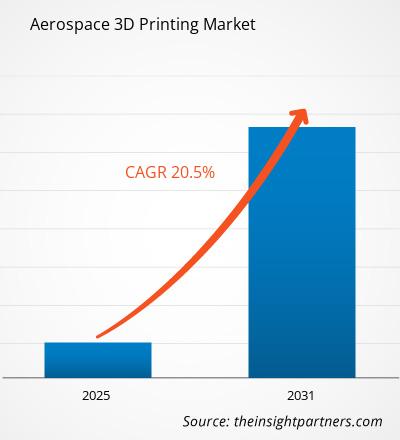Si prevede che il mercato della stampa 3D aerospaziale registrerà un CAGR del 20,5% dal 2025 al 2031, con una dimensione del mercato in espansione da XX milioni di dollari nel 2024 a XX milioni di dollari entro il 2031.
Il rapporto è segmentato per prodotto (materiale, stampante); tecnologia di stampa (SLA, SLS, DMLS, FDM, clip); applicazione (motore, struttura, componenti); utilizzo finale (aeromobili, elicotteri, UAV, veicoli spaziali). L'analisi globale è ulteriormente suddivisa a livello regionale e per i principali paesi. Il rapporto offre il valore in USD per l'analisi e i segmenti sopra indicati.
Scopo del rapporto
Il rapporto "Aerospace 3D Printing Market" di The Insight Partners mira a descrivere il panorama attuale e la crescita futura, i principali fattori trainanti, le sfide e le opportunità. Ciò fornirà spunti a vari stakeholder aziendali, come:
- Fornitori/produttori di tecnologia: per comprendere le dinamiche di mercato in evoluzione e conoscere le potenziali opportunità di crescita, consentendo loro di prendere decisioni strategiche informate.
- Investitori: per condurre un'analisi completa delle tendenze in merito al tasso di crescita del mercato, alle proiezioni finanziarie del mercato e alle opportunità esistenti lungo la catena del valore.
- Organismi di regolamentazione: per regolamentare le politiche e le attività di controllo nel mercato con l'obiettivo di ridurre al minimo gli abusi, preservare la fiducia degli investitori e sostenere l'integrità e la stabilità del mercato.
Segmentazione del mercato della stampa 3D aerospaziale Prodotto
- Materiale
- Stampante
Tecnologia di stampa
- SLA
- SLS
- DMLS
- FDM
- Clip
Applicazione
- Motore
- Strutturale
- Componenti
Uso finale
- Aeromobili
- Elicotteri
- UAV
- Veicoli spaziali
Potrai personalizzare gratuitamente qualsiasi rapporto, comprese parti di questo rapporto, o analisi a livello di paese, pacchetto dati Excel, oltre a usufruire di grandi offerte e sconti per start-up e università
Mercato della stampa 3D aerospaziale: Approfondimenti strategici

-
Ottieni le principali tendenze chiave del mercato di questo rapporto.Questo campione GRATUITO includerà l'analisi dei dati, che vanno dalle tendenze di mercato alle stime e alle previsioni.
Fattori di crescita del mercato della stampa 3D aerospaziale
- Domanda di componenti leggeri e ad alte prestazioni: poiché le aziende aerospaziali si impegnano a ridurre il consumo di carburante e ad aumentare l'efficienza, componenti leggeri e ad alte prestazioni sono essenziali. La stampa 3D consente la creazione di strutture complesse e leggere con design ottimizzati che i metodi di produzione tradizionali non possono ottenere. Questa capacità di produrre componenti personalizzati ad alta resistenza con un peso ridotto sta guidando l'adozione della stampa 3D nel settore aerospaziale, dove ogni grammo di riduzione di peso contribuisce al risparmio di carburante e al miglioramento delle prestazioni.
- Prototipazione e produzione rapide ed economiche: i produttori aerospaziali si stanno rivolgendo sempre più alla stampa 3D per ridurre i tempi e i costi di produzione. Le tecniche di produzione tradizionali spesso comportano processi lunghi e attrezzature costose, ma la stampa 3D consente una prototipazione più rapida e la possibilità di creare componenti su richiesta. Ciò non solo accelera i cicli di sviluppo del prodotto, ma riduce anche i costi di produzione di componenti complessi, rendendola una soluzione più interessante sia per le grandi che per le piccole aziende aerospaziali.
Tendenze future del mercato della stampa 3D aerospaziale
- Adozione della stampa 3D in metallo per componenti strutturali: la stampa 3D in metallo sta guadagnando terreno nel settore aerospaziale, in particolare per la creazione di componenti strutturali. Tecnologie avanzate di stampa in metallo, come la fusione laser selettiva (SLM) e la fusione a fascio di elettroni (EBM), consentono la produzione di parti metalliche complesse ed estremamente resistenti. Questi materiali, come il titanio e le leghe di alluminio, sono essenziali nelle applicazioni aerospaziali grazie al loro rapporto resistenza/peso e alla resistenza a condizioni estreme, rendendo la stampa 3D in metallo sempre più popolare per la produzione di aeromobili e veicoli spaziali.
- Crescente utilizzo della produzione additiva per i pezzi di ricambio: la tendenza a utilizzare la stampa 3D per la produzione di pezzi di ricambio e sostituzioni su richiesta è in crescita nel settore aerospaziale. Invece di mantenere grandi scorte, le aziende aerospaziali stanno sfruttando la stampa 3D per produrre pezzi di ricambio in base alle necessità, riducendo i costi di stoccaggio e i tempi di fermo. Questo cambiamento è particolarmente vantaggioso nel settore della manutenzione, riparazione e revisione (MRO), dove la consegna rapida di componenti critici è fondamentale per mantenere operativi gli aeromobili e ridurre al minimo le interruzioni operative.
Opportunità di mercato della stampa 3D aerospaziale
- Personalizzazione per applicazioni aerospaziali specializzate: la stampa 3D consente la produzione di componenti altamente personalizzati, adattati a specifici requisiti aerospaziali, come componenti su misura per velivoli senza pilota (UAV) o per l'esplorazione spaziale. Ciò rappresenta un'importante opportunità per le aziende aerospaziali di creare componenti unici nel loro genere, ottimizzati per prestazioni, adattamento e funzionalità, affrontando sfide progettuali uniche. La flessibilità della produzione additiva in termini di scelta dei materiali e complessità di progettazione offre un vasto potenziale per soddisfare esigenze aerospaziali specializzate.
- Espansione delle iniziative di esplorazione spaziale: con l'aumento degli investimenti nell'esplorazione spaziale e nelle missioni spaziali commerciali, la stampa 3D offre crescenti opportunità per la produzione di componenti di livello spaziale. La NASA e le aziende spaziali private stanno esplorando la produzione additiva per produrre componenti leggeri e resistenti per veicoli spaziali e habitat spaziali. Questo mercato presenta un immenso potenziale di crescita, poiché la stampa 3D consente la creazione di componenti direttamente nello spazio, riducendo la necessità di costose missioni di rifornimento e migliorando l'efficienza complessiva delle operazioni spaziali.
Mercato della stampa 3D aerospaziale
Le tendenze e i fattori regionali che hanno influenzato il mercato della stampa 3D aerospaziale durante il periodo di previsione sono stati ampiamente spiegati dagli analisti di The Insight Partners. Questa sezione illustra anche i segmenti e la geografia del mercato della stampa 3D aerospaziale in Nord America, Europa, Asia-Pacifico, Medio Oriente e Africa, America meridionale e centrale.
Ambito del rapporto sul mercato della stampa 3D aerospaziale
| Attributo del rapporto | Dettagli |
|---|---|
| Dimensioni del mercato in 2024 | US$ XX million |
| Dimensioni del mercato per 2031 | US$ XX Million |
| CAGR globale (2025 - 2031) | 20.5% |
| Dati storici | 2021-2023 |
| Periodo di previsione | 2025-2031 |
| Segmenti coperti |
By Prodotto
|
| Regioni e paesi coperti |
Nord America
|
| Leader di mercato e profili aziendali chiave |
|
Densità degli operatori del mercato della stampa 3D aerospaziale: comprendere il suo impatto sulle dinamiche aziendali
Il mercato della stampa 3D aerospaziale è in rapida crescita, trainato dalla crescente domanda degli utenti finali, dovuta a fattori quali l'evoluzione delle preferenze dei consumatori, i progressi tecnologici e una maggiore consapevolezza dei vantaggi del prodotto. Con l'aumento della domanda, le aziende stanno ampliando la propria offerta, innovando per soddisfare le esigenze dei consumatori e sfruttando le tendenze emergenti, alimentando ulteriormente la crescita del mercato.

- Ottieni il Mercato della stampa 3D aerospaziale Panoramica dei principali attori chiave
Punti di forza
- Copertura completa: il rapporto analizza in modo esaustivo prodotti, servizi, tipologie e utenti finali del mercato della stampa 3D aerospaziale, offrendo una panoramica olistica.
- Analisi degli esperti: il rapporto è redatto sulla base della conoscenza approfondita di esperti e analisti del settore.
- Informazioni aggiornate: il rapporto garantisce la pertinenza aziendale grazie alla copertura di informazioni e tendenze dei dati recenti.
- Opzioni di personalizzazione: questo rapporto può essere personalizzato per soddisfare le esigenze specifiche del cliente e adattarsi in modo appropriato alle strategie aziendali.
Il rapporto di ricerca sul mercato della stampa 3D aerospaziale può quindi contribuire a guidare il percorso di decodificazione e comprensione dello scenario del settore e delle prospettive di crescita. Sebbene possano esserci alcune valide preoccupazioni, i vantaggi complessivi di questo rapporto tendono a superare gli svantaggi.
- Analisi storica (2 anni), anno base, previsione (7 anni) con CAGR
- Analisi PEST e SWOT
- Valore/volume delle dimensioni del mercato - Globale, Regionale, Nazionale
- Industria e panorama competitivo
- Set di dati Excel
Report recenti
Rapporti correlati
Testimonianze
Motivo dell'acquisto
- Processo decisionale informato
- Comprensione delle dinamiche di mercato
- Analisi competitiva
- Analisi dei clienti
- Previsioni di mercato
- Mitigazione del rischio
- Pianificazione strategica
- Giustificazione degli investimenti
- Identificazione dei mercati emergenti
- Miglioramento delle strategie di marketing
- Aumento dell'efficienza operativa
- Allineamento alle tendenze normative






















 Ottieni un campione gratuito per - Mercato della stampa 3D aerospaziale
Ottieni un campione gratuito per - Mercato della stampa 3D aerospaziale